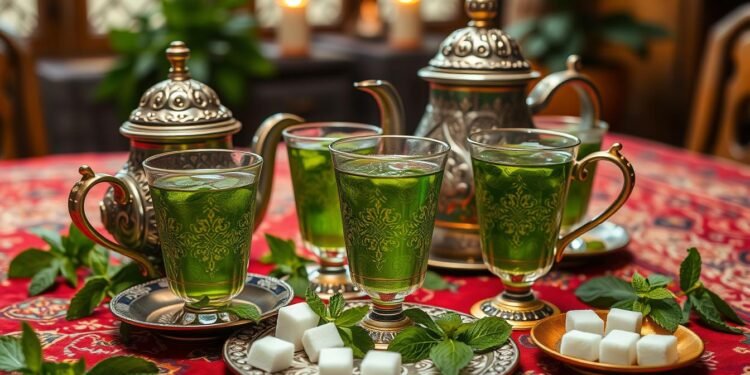Step into the vibrant world of Moroccan mint tea. It’s a drink that captures Morocco’s rich culture. This traditional tea is more than a drink; it’s a symbol of hospitality and a key part of social gatherings.
With its unique mix of gunpowder green tea, fresh mint, and sugar, Moroccan mint tea offers a refreshing experience. It’s cherished in Morocco and loved worldwide.
As Morocco’s national drink, it holds a special place in daily life. It’s enjoyed throughout the day, pairing well with both sweet and savory foods. The strong green tea and invigorating mint make a robust yet refreshing flavor. It’s perfect for any occasion, whether you’re looking for calm or celebrating with friends.
Key Takeaways
- Moroccan mint tea is a symbol of hospitality in Morocco
- It combines gunpowder green tea, fresh mint, and sugar
- The tea is versatile and enjoyed throughout the day
- It’s served with both sweet and savory foods
- Moroccan mint tea has cultural significance beyond Morocco
- The drink offers a unique blend of robust and refreshing flavors
The Cultural Significance of Moroccan Mint Tea
Moroccan mint tea is a big part of the country’s culture. Introduced in the 18th century, it’s a daily staple. The mix of green tea and fresh mint stands for endurance, freshness, and giving.
It’s not just a drink; it’s a way to show hospitality and connect with others.
A Symbol of Moroccan Hospitality
In Morocco, serving mint tea is a sign of true hospitality. It’s called “Atay Naa Naa.” Hosts make one or two teapots, showing respect to their guests.
The first pour, Errouh, is seen as the tea’s soul. This shows the importance of moroccan hospitality customs.
The Role of Tea in Daily Life
Moroccan mint tea is enjoyed all day. It’s not just for drinking; it’s packed with antioxidants and menthol. These ingredients help soothe stomachs, ease headaches, and refresh the mind.
So, it’s a big part of Moroccan life, loved for its taste and health benefits.
Tea Time: A Social Ritual
Tea time in Morocco is a special moment. Families and friends come together, enjoying mint tea and each other’s company. Pouring tea from high is a sign of respect and friendship.
In the desert, Tuareg nomads give three rounds of tea. Each round has its own meaning. This tradition strengthens bonds and brings people closer.
The Origins and History of Moroccan Mint Tea
Moroccan green tea, a favorite in the Maghreb, has a long history. It started in the late 17th or early 18th century. This tea, also known as Maghreb mint tea, spread to Algeria, Tunisia, and Libya.
It became popular in cities as a sign of wealth and status. The main ingredients are Chinese green tea, fresh mint, sugar, and boiling water. This mix created a unique taste that’s key to the region’s social life.
Traditionally, people drink at least three glasses a day. Each glass has a different flavor, depending on how long it’s steeped.
By the early 20th century, French rule made Moroccan mint tea even more popular. It was a way for rural farmers to connect with city life. Now, it’s a big part of Moroccan culture and daily life. People also add wormwood, lemon verbena, or sage to the mint for extra flavor.
Essential Ingredients for Moroccan Mint Tea
Moroccan mint tea is a mix of flavors that needs just a few key ingredients. It combines the bold taste of gunpowder green tea with the coolness of fresh mint. Let’s look at the main parts that make up this favorite mint tea.
Gunpowder Green Tea: The Base
The base of Moroccan mint tea is gunpowder green tea. Its leaves are tightly rolled, looking like small pellets. This tea has a strong, smoky flavor and more caffeine than regular green tea. For a 500ml serving, use one heaping teaspoon of loose gunpowder tea.
Fresh Mint: The Star of the Show
Fresh mint is the main ingredient that gives Moroccan mint tea its unique taste. Usually, seven sprigs of mint are used for each serving. Spearmint is the most common, but peppermint or a mix can also be used. The mint adds a cool, refreshing flavor that balances the green tea’s boldness.
Sugar: Sweetness to Taste
Moroccan mint tea is traditionally sweet. About three tablespoons of sugar are added to a 500ml serving. You can adjust the sweetness to your liking. The sugar adds sweetness and softens the strong flavors of the tea and mint.
These three simple ingredients come together to make a complex and satisfying mint tea blend. It’s loved in Morocco and around the world. With the right mix, this drink is both invigorating and soothing, great for any time.
Traditional Moroccan Tea Equipment
Making traditional Moroccan tea needs special tools. The key piece is the Moroccan teapot, or berrad. It’s made of metal, can handle high heat, and has a long spout for pouring.
The berrad comes in different sizes. It’s big enough for several servings of tea.
Along with the teapot, there are small, colorful glasses without handles. These glasses are not just useful but also make the tea service look beautiful. They often come in a set and are served on an ornate tray.
A tea strainer is also important for making Moroccan tea. It filters out tea leaves and mint stems when pouring the tea. Some teapots have built-in strainers, while others need a separate tool.
Making Moroccan mint tea is a slow and careful process. It takes about 30 minutes to get it just right. The tea is steeped carefully, and sugar is caramelized. This patience makes the tea flavorful and aromatic, a key part of Moroccan hospitality.
The Art of Brewing Moroccan Mint Tea
The moroccan tea ritual is a cherished tradition. It shows the art of brewing and serving this refreshing beverage. The process requires patience, skill, and attention to detail. Let’s explore the steps involved in creating this iconic drink.
Step-by-Step Brewing Process
To start, rinse the gunpowder green tea leaves in hot water. Then, add fresh mint and sugar to the teapot. Pour boiling water over the ingredients and let it steep slowly. This careful approach allows the flavors to blend perfectly, creating the signature taste of traditional moroccan tea.
The Importance of the Pour
The pouring technique is key in the moroccan tea ritual. Tea is poured from a height into glasses, creating a frothy top and mixing the sugar evenly. This process is repeated several times to ensure the perfect blend. The high pour also cools the tea slightly, making it ready to drink.
Serving Etiquette
Serving moroccan mint tea is an art form in itself. The host pours the tea into small glasses from a height, showing their skill and hospitality. This gesture is a sign of respect and warmth towards guests. The first glass is often the strongest, while subsequent pours become milder and sweeter.
Mastering the art of brewing and serving traditional moroccan tea takes practice. Each step, from steeping to pouring, plays a vital role in creating this beloved drink. The ritual not only produces a delicious beverage but also strengthens social bonds and celebrates Moroccan culture.
Moroccan Mint Tea: A Refreshing Brew
Moroccan mint tea is a refreshing drink that shows the heart of North African culture. It mixes Chinese green tea with fresh mint for a unique taste. This tea is great for any time, whether with meals or on its own.
Making Moroccan mint tea is an art. Traditionally, two teaspoons of tea leaves soak in boiling water for 15 minutes. Adding sugar makes it sweet. Most tea has about one teaspoon of sugar per 3 ounces, but you can adjust it.
The way it’s served is also special. Moroccan mint tea is poured three times into small glasses. Each pour changes the flavor, from soft to strong to slightly bitter. This lets you enjoy different tastes in one sitting.
But Moroccan mint tea is more than just tasty. It’s full of antioxidants from the green tea and mint helps with digestion and colds. It’s perfect for a calm moment or a refreshing pick-me-up.
Health Benefits of Moroccan Mint Tea
Moroccan green tea is packed with health benefits. It’s a mint tea blend that’s full of nutrients. It’s rich in antioxidants, which help clean your body and boost your immune system.
The menthol in mint soothes your respiratory tract. It acts as an anti-inflammatory and anti-spasmodic agent.
This refreshing tea is full of minerals like fluoride, calcium, magnesium, copper, and selenium. These minerals support your immune function and overall health. Vitamin B3 in Moroccan mint tea helps balance your cholesterol levels.
Moroccan green tea aids digestion and weight loss. Its caffeine promotes proper digestion. The catechin antioxidants may help reduce abdominal fat.
For skin health, the Vitamin C in this tea reduces fine lines and lightens dark spots. Its antioxidants and flavonoids boost skin elasticity and healing.
To enjoy these benefits, steep 3-4 Moroccan mint tea bags in hot water for up to three minutes. Add honey for sweetness. Remember, moderation is key to enjoying this delightful beverage fully.
Variations and Modern Twists on the Classic Recipe
Moroccan mint tea, a mix of green tea and fresh mint, has inspired many variations. Tea enthusiasts now enjoy new flavors while keeping its refreshing taste.
Seasonal Herb Additions
In winter, Moroccans add warm herbs to their mint tea. Sage or artemisia add a cozy feel, great for cold nights. These herbs bring unique flavors while keeping the tea refreshing.
Adjusting Sweetness Levels
Traditionally, Moroccan mint tea is very sweet. But today, many prefer less sugar. This lets the green tea and mint’s natural flavors stand out. Adjusting the sweetness makes it enjoyable for everyone.
Iced Moroccan Mint Tea
As summers get warmer, iced Moroccan mint tea is becoming more popular. It’s a cool twist on the classic, perfect for hot days. Some recipes add orange blossom water or lemon for a refreshing twist.
FAQ
What is the cultural significance of Moroccan mint tea?
Moroccan mint tea holds a special place in Moroccan culture. It symbolizes hospitality and friendship. When guests arrive, they are often greeted with a cup of tea.
The act of making and sharing tea is a cherished tradition. It brings people together and strengthens bonds.
What are the key ingredients in Moroccan mint tea?
To make authentic Moroccan mint tea, you need a few key ingredients. These include gunpowder green tea, fresh mint, and sugar.
What equipment is traditionally used to make Moroccan mint tea?
Traditional equipment is used to brew Moroccan mint tea. A metal Moroccan teapot or stovetop kettle is used for brewing. Small, decorative glasses are used for serving.
How is Moroccan mint tea brewed?
Brewing Moroccan mint tea is a detailed process. First, the tea leaves are rinsed. Then, mint, sugar, and water are added.
The mixture is slowly brought to a boil for steeping. When pouring, the tea is poured from a height. This creates a frothy top and mixes the sugar.
What are the health benefits of Moroccan mint tea?
Moroccan mint tea has several health benefits. The green tea base is full of antioxidants. Mint helps with digestion, and the caffeine gives a gentle energy boost.
But, the traditional high sugar content is something to consider. It’s important for those watching their sugar intake.
Are there any variations or modern twists on the classic Moroccan mint tea recipe?
Yes, there are variations and modern twists on traditional Moroccan mint tea. Some add seasonal herbs like artemisia or sage in winter. Others adjust the sweetness or make iced tea for summer.
Some recipes also include lemon or orange blossom water for extra flavor.




























